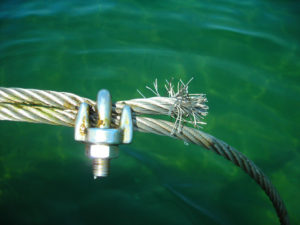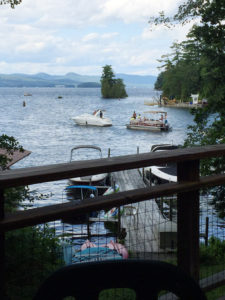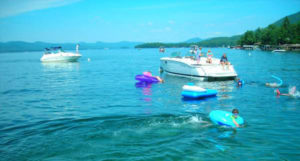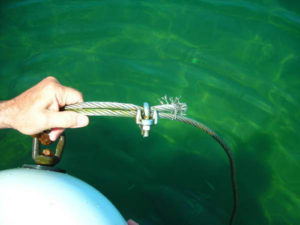By Mark Frost, Chronicle Editor
Two Chronicle readers have contacted us in recent days aiming to alert people to separate hazards they’ve come across on Lake George.
At Sandy Bay, a shallow, very popular spot for boats to moor and people to frolic, the concern is the sharp strands at the end of the steel cable that holds the mooring buoy in place.

At Isom Bay, up the lake’s east side just north of Echo Bay, the issue is rocks that boaters keep running onto because they mis-read the buoys that are meant to warn: Danger. Because there’s an invitingly wide gap between the buoys, some unwary boaters assume it indicates there’s a safe channel right up the middle. They assume wrong.
Daniel J. Pratt, who grew up in Hudson Falls and is an architect in Rutland, Vermont, has a straight-on view from the front porch of his Isom Bay camp.
“Hi, I am at my family camp,” he wrote in the first of a series of letters to us. “This is my 71st year on the lake and while many in our bay have contacted authorities about boats continually wrecking on underwater rock ledges near the surface, no authority corrects the problem and the wrecks continue.

“Today alone, three boats, the drives and props have hit the rocks and been damaged, one boat sheared off its prop and the boat is being towed away. This is all too common at Isom Bay and nearly every day we are here, a boat and its occupants are perplexed by their untimely and easily preventable wreck.
“Here is the issue in a nutshell. There are two danger buoys placed nearby, and many people understand that the danger buoys mean stay away. There are plenty of boaters that see the danger buoys and think they are there to guide them into the bay. This unintended but real invitation lures boaters onto and into the rocks.

Mr. Pratt says, “Last year a sheriff’s boat with two officers struck the role shoal, lifted up their engine, saw the damage that had been done and after about 15 minutes limped off. We — my wife and I — thought, surely something will be done now to fix the problem. Nothing has been done.

“Locals have tried to fix the problem just to be told they can’t move the buoys or tie a string of rope with additional small buoys between to help boaters navigate away from the real danger, the rocks that lie beneath the surface directly between these two inviting buoys.”
The Chronicle aims to follow up and report back to you next week about both the Isom Bay and Sandy Bay concerns.
Copyright © 2017 Lone Oak Publishing Co., Inc. All Rights Reserved.
 Glens Falls Chronicle Serving the Glens Falls/Lake George region; Warren, Washington and northern Saratoga counties since 1980
Glens Falls Chronicle Serving the Glens Falls/Lake George region; Warren, Washington and northern Saratoga counties since 1980

